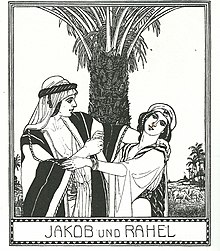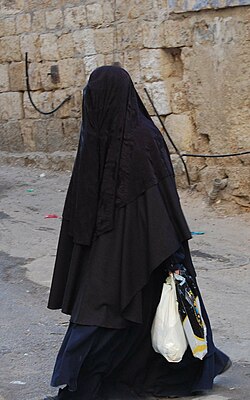Head covering for Jewish women

According tohalacha(Jewish law), marriedJewishwomen are expected to cover their hair when in the presence of men other than their husband or close family members. Such covering is common practice nowadays amongOrthodox Jewishwomen.
Different kinds of head coverings are used, among them themitpaḥatortichel(headscarf),shpitzel,snood,hat, beret, fall, bonnet, veil, headscarf, bandana, andsheitel(wig). The most common head coverings in the Haredi community are headscarves in the form of the tichel and snood, though some wear hats,beretsor sheitels; the tichel and snood remain the historic and universally accepted rabbinical standard for observant Jewish women.[1]The headscarves can be tied in a number of ways, depending on how casually the wearer is dressed.
Covering the hair is part of the modesty-related dress standard calledtzniut.
Laws
[edit]According to Jewish law (halacha), a woman mustcover her hairafter marriage.[2][3]The requirement applies in the presence of any men other than her husband, son, father, grandson, grandfather, or brother,[4]though a minority opinion allows uncovering hair within one's home even in the presence of unrelated men.[5]
The obligation to cover hair applies in public areas.[5]In a private home, some sources recommend hair covering (even in the absence of unrelated men), but the consensus is that hair may be uncovered if no unrelated men are present.[4]
The consensus is that all or most of the hair must be covered.[6]Some sources rule that every single hair must be covered,[7]but many others permit a small amount of hair (each source defines the amount differently) to emerge from the head-covering.[8][6]
Various reasons have been suggested for this head-covering, among them:
- Historically, head-covering was considered a form of dignity for a woman, and to have one's head-covering removed was a source of humiliation.[9]
- Married women are expected to behave with a higher level of sexual modesty than single women, due to the commitment they have made to their husbands, and covering their potentially alluring hair is one aspect of this.[9]
- Head covering is a sign of a woman's married status, which (among other things) could indicate to men that she is unavailable to them.[9]
- Head-covering indicates awe when standing before God, similar to thekippahfor men.[9]
- Nowadays, head-covering also serves a sign of identification with the religious Jewish community.[9]
Sources
[edit]
Numbers 5:18[10]requires, as part of thesotahritual, that a married woman's head be madeparua(a word which has been understood to mean 'uncovered' or 'with loose hair'),[11]suggesting that, normally, her hair is notparua.According to the Talmud, this indicates that the Torah prohibits married women in general from appearingparuain public.[12][13]
TheMishnah,however, implies that hair covering is not an obligation of biblical origin. It discusses behaviors that are grounds for divorce, such as, "appearing in public with aparuahead, weaving in the marketplace, and talking to any man ", and calls these violations ofDat Yehudit[a]('Jewish law') as opposed toDat Moshe('Mosaiclaw').[14]TheTalmudreconciles the sources by saying that if her head is completely uncovered in public, this would indeed be a violation ofDat Moshe,whereas a woman who appears in public wearing akalta(a minimal covering of part of the hair, perhaps a basket resting on the head)[15]has satisfiedDat Moshebut is still violatingDat Yehudit.[12]
Another relevant Talmudic source isBerakhot24a, where the rabbis define hair as sexually erotic (ervah), and prohibit men from praying in sight of a married woman's hair. The rabbis base this judgement on a biblical verse: "Your hair is like a flock of goats" (Song of Songs 4:1),[16]suggesting that this praise reflects the sensual nature of hair.[17]However, "with a few exceptions, there is halachic consensus that the obligation of women's head-covering derives chiefly from the sota and, secondarily, from dat Yehudit", rather than fromervah,[18]and a number of leadingposkimruled that while head-covering is required, in societies where this law is widely ignored, the uncovered hair ceases to be consideredervahfor the purpose of prayer.[19]
TheZohar,a commentary on the Hebrew Scriptures and the primary source of the beliefs ofKabbalah,also describes the mystical importance of women making sure to not expose their hair. The parashatNaso125b–126b[20]suggests that a woman who strictly obeys head covering traditions will reap many blessings for her husband and children.
Unmarried women
[edit]The medieval codes do not mention any exemption for unmarried women.[21]According to the Mishna, if a woman went to her wedding with hair uncovered, this serves as proof that she was a virgin (i. e., never before married) at the time.[22]This seems to indicate that never-married women did not cover their hair, but divorced and widowed women did continue to cover their hair. This is also the position taken by theJerusalem Talmud[23]and is generally the accepted ruling today.[24]However, R'Moshe Feinsteinpermitted divorced and widowed women to uncover their hair in cases of great need, for example, when a head covering might interfere with dating or obtaining a job.[25]Exact rulings in such cases vary depending on the community and the individual's situation.[24]
InYemen,unmarried girls covered their hair like their Muslim peers;[26]however, uponYemeni Jews' emigration to Israel and other places, this custom has been abandoned.Aharon Rothpraised this custom.[27]Magen Avrahamruled that while unmarried women need not cover their hair, they must braid it so that it is not disheveled.[28]This ruling is practiced in someHasidiccommunities nowadays.[24]
When a woman gets married, opinions differ regarding when exactly she must begin covering her head: after betrothal (rare today), after thechuppahceremony, afteryichud,or only after the couple has spent a night together.[24]Even according to the more stringent opinions, thebridal veil(which partly covers the hair) may be considered sufficient cover for the remainder of the ceremony.[24]
Non-Orthodox Judaism
[edit]Conservative and Reform Judaism do not generally require women to wear head coverings. Some more traditional Conservative synagogues may ask that married women cover their heads during services. However, some more liberal Conservative synagogues suggest that women, married or not, wear head-coverings similar to those worn by men (thekippah/yarmulke); and some require it (or require it only for women receiving honors or leading services from thebimah) – not for modesty, but as afeministgesture ofegalitarianism.[29]
In the 21st century, some non-Orthodox Jewish women began covering their heads or hair with scarves, kippot, or headbands.[30]Reasons given for doing so included as an act of spiritual devotion,[31]as expression of ethnic identity, as an act of resistance to a culture that normalizes the exposure of the body,[32]or as a feminist reclamation of modest dress, a practice sometimes seen as non- or anti-feminist.[33]
Mitpaḥat
[edit]
Mitpaḥat(Hebrew:מִטְפַּחַתmiṭpaḥat), also called atichel(Yiddish:טיכלtikhl), is theheadscarfworn covering the hair.[34]Mitpaḥot can range from a plain scarf of any material worn over the hair to elaborate head coverings using multiple fabrics and tying techniques.
According toIbn Ezra,already in Biblical times, Israelite women wore a form of cloth head covering similar to that worn by Muslim women in his own time (12th century).[35]
Etymology
[edit]The word Mitpaḥat is a Hebrew word which literally means a covering or mantle, though is also used to mean many other things such as towel, apron, bandage, or wrap. Its current meaning is taken from post-biblical Hebrew, and is most likely derived from the Hebrew word טִפַּח (tipaḥ), meaning spread out or extended.[36]
The Yiddish wordtichelis thediminutiveoftuch( "cloth" ). Compare GermanTuch( "cloth" ), and the correspondingBavariandiminutiveTiachal, Tücherl( "small piece of cloth" ).
Shpitzel
[edit]
Ashpitzel(Yiddish:שפּיצל) is a head covering worn by some marriedHasidicwomen. It is a partial wig that only has hair in the front, the rest typically covered by a smallpillbox hator aheadscarf.[37]The hairpiece may actually be silk or lace, or else made of synthetic fibers, to avoid too closely resembling real hair.[38]The shpitzel was popular among HungarianHasidimin the 19th century, and it is worn by some contemporary women who follow the customs of that community.
Etymology
[edit]The Yiddish word "Shpitzel" is related to the grammatical diminutive of the high-German word "Spitze" which can either mean "point" or "lace"; the latter translation is most likely the right one in the context of this article.
The termshpitzelmay also be used to refer to theends of a loaf of breadin some dialects.[39]In this case, the above-mentioned translation "Spitze" = (end)point/peak is applicable, with its High German grammatical diminutive "Spitzchen".
Sheitel
[edit]
Sheitel(Yiddish:שייטל,sheytln.sg.;שייטלעך,sheytlekhn.pl. orשייטלען,sheytlenn.pl.) is awigor half-wig. The related term inHebrewispei'ah(פאה) orpei'ah nochrit(פאה נוכרית).[40]The Sheitel started to be used by some Jewish women as a headcovering in the 18th century, though its use has been opposed by traditional rabbis.[1]
Traditional sheitels are secured by elastic caps, and are often designed with heavy bangs to obscure the hairline of their wearers. More modernlace-front wigswith realistic hairlines or real hair are growing in popularity.[40]
Some modern Orthodox women cover their hair with wigs. A style of half wig known as a "fall" has become increasingly common in some segments of Modern and Haredi Orthodox communities.[41]It is worn with either a hat or a headband.
Acceptability
[edit]The practice of covering hair with wigs is debated amonghalakhicauthorities. Many authorities, including RabbiMoshe Feinstein,[42]permitted it, and theLubavitcher Rebbeactively encouraged it,[43]while many other authorities, especially Sephardi rabbis, forbid it. SomeHasidicgroups encourage sheitels, while others avoid them.[44]In many Hasidic groups, sheitels are avoided, as they can give the impression that the wearer's head is uncovered. In other Hasidic groups, women wear some type of covering over the sheitel to avoid this misconception, for example a scarf or a hat. MarriedSephardiandNational Religiouswomen do not wear wigs, because their rabbis believe that wigs are insufficiently modest, and that other head coverings, such as a scarf (tichel), asnood,a beret, or a hat, are more suitable. In stark contrast, theChabadrebbe,Menachem Mendel Schneerson,encouraged all married Jewish women to wear sheitels, though in Torat Menachem, he writes that in fact, "if she can cover her hair with a scarf, it is definitely good if she would do so, but in reality, we know that this doesn't happen."[44][45]
In 2004, controversy arose over natural hair sheitels procured from India when Rabbi Elyashiv announced a prohibition on the use of Indian hair in Jewish wigs.[46]It was discovered that the hair used for the production of these wigs was taken from aHindu templewhere pilgrims travelled to undergo the ritual oftonsure(head shaving). According to Jewish law, one cannot derive benefit from anything used in practicesconsidered to be idolatry.Today, many wigs used by Jewish women come with ahechsher(kosher certification), indicating that they are not made with hair originating from rituals deemed to be idolatrous.[47]Kosher certification also implies that the sheitels are recognizable as wigs, no longer than the top vertebra of the spinal cord, and appear neat and modest.
Shal
[edit]
Theshal(shālשָאל,lit. 'shawl')—also called afrumka,a portmanteau of theYiddish-language wordfrumand theArabic-language wordburqa—is a garment which fully covers the body and face. It is associated with Israeli fundamentalist groups such as theHaredi burqa sectandLev Tahor,making it highly controversial.[48][49]Proponents of the shal are pejoratively referred to as “Talibanmothers”[50]or the “Taliban sect”[51]whose practices are an innovation that has “no basis whatsoever inhalachah.”[52]
However, face veils are known historically to have been worn by Jewish women.Marc B. Shapirohas written that there are some traditional sources which describe and praise the custom of modest Jewish women covering their faces,[53]including the Babylonian Talmud,[54][55]Jerusalem Talmud,[56]Mishnah,[57]andMishneh Torah.[58]Jewish women in the Islamic world maintained this type of traditional clothing “until even the mid-20th century,” since “Jews dressed in the style of the surrounding society”[59]and therefore wore garments typically regarded as entirely “Islamic dress,” such as thechador,niqab,and burqa.[60]
Gallery
[edit]- Types of Jewish women's headcoverings
-
Shuli Mualem,an Israeli politician, wearing a cap
-
Politician Batya Kahana Dror wearing a headscarf that does not cover all of her hair
-
A 19th century Belarusian Jewish woman wearing a wig underneath a silk cap or bonnet
-
19th century Tunisian Jewish girls wearing headscarves
-
Yemenite Jewish girls wearing gargush caps
-
A just-married Jewish woman in a white headscarf at her wedding in the late 20th century
-
A painting of late 19th or early 20th century Polish Jewish women in synagogue, wearing decorated caps with shawls over them
-
Indian Jewish women. One, seated, is wearing a kippah
-
A woman wearing a headwrap that exposes a "tefach" (maximum acceptable amount) of hair
-
AHarediwoman wearing a black headscarf with padding at the hairline
-
Yonina Eldar, a professor, wearing asheitel
References
[edit]- ^abCahn-Lipman, David E. (1991).The Book of Jewish Knowledge: 613 Basic Facts about Judaism.Jason Aronson. p. 146.ISBN978-0-87668-575-4.
In the late eighteenth century, women began covering their heads with a wig (a sheitel). Ironically, many rabbis opposed this innovation because they saw it as being indecent.
- ^Shulchan Aruch,Even Ha'ezer 115, 4; Orach Chayim 75,2; Even Ha'ezer 21, 2
- ^Schiller, Mayer."The Obligation of Married Women to Cover Their Hair"Archived2008-04-07 at theWayback Machine.JHCS30, 1995, 81–108.
- ^abHair covering at home
- ^abDeracheha: Women and Head-Covering V: Where
- ^abDeracheha: Women and Head-Covering IV: How
- ^Magen Avraham 75:4; Chatam Sofer I:36
- ^Rema,Orach Chaim 75:2; Igrot Moshe, Even Haezer 1:58; R'Ovadiah Yosef(quoted inEt Tzenu'im Chochma79a)
- ^abcdeDeracheha: Women and Head-Covering II: Rationale and Meaning
- ^Numbers 5:18
- ^'וראשה פרוע'
- ^abKetubot 72a-72b
- ^Yakov Yitzchak Fuks (1989).Halichot Bat Yisrael(in Hebrew). Jerusalem.
{{cite book}}:CS1 maint: location missing publisher (link) - ^Mishnah,Ketuboth7:6
- ^Jastrow dictionary, קַלָּת
- ^Song of Songs 4:1
- ^Brachot 24a
- ^Women and Head-Covering I: Halachic Basis
- ^R'Moshe Feinstein,Igrot Moshe, Orach Chaim 1:42;Aruch HaShulchan,Orach Chaim 75:7, etc.
- ^"Hair Covering in Jewish Law | Sefaria".sefaria.org.Retrieved2022-04-21.
- ^e.g.Mishneh Torah,Issurei Biah21:16,SeMaG,lo Taaseh126,Orchot Chaim,Ketubot34,Tur,Even haEzer21,Shulchan Arukh,Even haEzer21:2.
- ^Mishnah Ketubot 2:1
- ^Jerusalem Talmud, Ketubot 2:1
- ^abcdeDeracheha: Women and Head-Covering III: Who
- ^Igrot Moshe, Even Haezer 1:57 and 4:32:4
- ^"Dress Codes: Revealing the Jewish Wardrobe"Archived3 July 2014 at theWayback Machine,An exhibition focusing on this collection was presented at the Israel Museum, Jerusalem 11 March 2014 – 18 October 2014
- ^Sefer Shomer Emunim, Rav Aharon Rothzt "l
- ^Magen Avraham, 75:3
- ^Kaplan Sommer, Alison (Dec 15, 2013)."Should a Jewish Woman Cover Her Head... With a Yarmulke?".Haaretz Daily Newspaper Ltd. Haaretz.Retrieved19 September2022.
- ^Bernstein, Alyx (3 February 2020)."Headband Nation".Tablet.Retrieved19 September2022.
- ^Kent, Aiden (29 August 2022)."We Need More Jewish Modest Style Influencers".Alma.70/Faces Media.Retrieved19 September2022.
- ^Pockrass, Ally (8 March 2018)."Why These Secular Jewish Women Are Covering Their Hair".Alma.70/Faces Media.Retrieved19 September2022.
- ^Jacobi, Zo (24 June 2021)."A Short History of Tichels and the Modern Resurgence".Jewitches.Archived fromthe originalon 20 September 2022.Retrieved19 September2022.
- ^Encyclopedia of Judaism: Tichel
- ^Ibn Ezra to Exodus 38:8
- ^Klein, Ernest (1987).A Comprehensive Etymological Dictionary Of The Hebrew Language.Jerusalem: Carta Jerusalem.ISBN965220093X.
- ^Hella Winston (15 November 2006).Unchosen: The Hidden Lives of Hasidic Rebels.Beacon Press. pp. 21, 181.ISBN978-0-8070-3627-3.Retrieved13 January2013.
- ^Elbinger, Naomi (18 December 2011)."The Tichel: A Short History of Headcovering Fashion".MavenMall Blog.Archived fromthe originalon 2013-03-08.Retrieved8 March2013.
- ^Vaux, Bert."Dialect Survey: What do you call the end of a loaf of bread?".RetrievedJanuary 13,2013.
- ^abSherman, Julia (November 17, 2010)."She goes covered".
- ^"Orthodox Jewish Women Wigs and Hair Replacement Systems | William Collier Design".williamcollierdesign.Retrieved2024-04-25.
- ^Rav Moshe Feinstein (29 October 2007).Igros Moshe, Even HaEzer chelek 2, siman 12.
- ^All over his published correspondence
- ^abLetters on the importance of wearing a sheitel from the Lubavitcher Rebbe
- ^"Torat Menachem תשי" ד P. 189-190 "
- ^Wakin, Daniel J. (2004-05-14)."Rabbis' Rules and Indian Wigs Stir Crisis in Orthodox Brooklyn".The New York Times.ISSN0362-4331.Retrieved2022-04-21.
- ^hair sources and background."Kosher Wigs".prweb.RetrievedAugust 17,2013.
- ^Blomfield, Adrian (July 30, 2010)."Israeli rabbis clamp down on burka".The Telegraph.Archived fromthe originalon November 18, 2018.RetrievedJune 11,2024.
- ^Fogelman, Shay (March 9, 2012)."Lev Tahor: Pure as the Driven Snow, or Hearts of Darkness?".Haaretz.Archived fromthe originalon May 17, 2014.RetrievedJune 11,2024.
- ^Shaviv, Miriam (April 18, 2011)."France's Ban, and Israel's Burka Problem".The Forward.Archived fromthe originalon October 18, 2011.RetrievedJune 11,2024.
- ^Rosenberg, Oz (October 5, 2011)."Court to rule on legality of Israeli ultra-Orthodox 'Taliban sect'".Haaretz.Archived fromthe originalon October 7, 2011.RetrievedJune 11,2024.
- ^Shaviv, Miriam (January 25, 2011)."Should Israel Ban the Burka?".The Jewish Chronicle.Archived fromthe originalon August 1, 2010.RetrievedJune 11,2024.
- ^Shapiro, Marc B. (June 11, 2012)."Taliban Women and More".The Seforim Blog.WordPress.RetrievedJune 4,2024.
- ^"Sotah 10b:3".Sefaria.
- ^"Shabbat 80a:7".Sefaria.
- ^"Shabbat 8:3:5".Sefaria.
- ^"Shabbat 6:6".Sefaria.
- ^"Marriage 13:11".Sefaria.
- ^Tobin, Andrew (September 28, 2017)."When Jews wore burkas: An exhibit showcases unexpected Jewish fashion".Jewish Telegraphic Agency.RetrievedJune 11,2024.
- ^Jewish woman’s wrap (izar) and face veil (khiliyye)(Silk, gilt metal thread; veil: horsehair). Jerusalem:Israel Museum.RetrievedJune 11,2024.
External links
[edit]- Derachehaarticle series on women's head covering:halachic basis,rationale and meaning,who must cover,how to cover,where to cover
- An Orthodox Woman Wears Many Hats: How To Blend In While Standing Out












